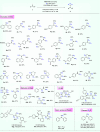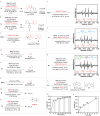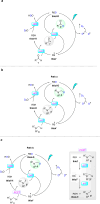Photocatalyst-free photochemical deuteration via H/D exchange with D2O
- PMID: 40695788
- PMCID: PMC12284205
- DOI: 10.1038/s41467-025-61641-0
Photocatalyst-free photochemical deuteration via H/D exchange with D2O
Abstract
Deuterium labeling is increasingly important across scientific fields, from drug development to materials engineering, but current methods often require expensive catalysts. Here we demonstrate a simple, photocatalyst-free approach for incorporating deuterium into organic molecules using visible light. By employing common thiol compounds under mild blue-light irradiation (380-420 nm), we successfully modify two key chemical groups (formyl and α-amino) with high efficiency (up to 96% deuterium incorporation). This method eliminates the need for specialized PCs, significantly reducing costs and complexity. Surprisingly, we find that the system generates reactive intermediates (thiyl radicals and hydrogen atoms) through previously unrecognized light-activated pathways. These discoveries challenge conventional assumptions about photochemical deuteration and offer practical advantages for both laboratory research and industrial-scale production. Our results provide a more sustainable and scalable route to deuterated compounds while opening possibilities for light-driven chemistry without expensive catalysts. This work advances isotope labeling technology and suggests broader applications for simple, light-powered reactions in chemical synthesis.
© 2025. The Author(s).
Conflict of interest statement
Competing interests: The authors declare no competing interests.
Figures






Similar articles
-
Light-Driven C(sp3)-C(sp3) Bond Functionalizations Enabled by the PCET Activation of Alcohol O-H Bonds.Acc Chem Res. 2025 Jul 1;58(13):2061-2071. doi: 10.1021/acs.accounts.5c00246. Epub 2025 Jun 13. Acc Chem Res. 2025. PMID: 40511721
-
Organic Synthesis Away from Equilibrium: Contrathermodynamic Transformations Enabled by Excited-State Electron Transfer.Acc Chem Res. 2024 Jul 2;57(13):1827-1838. doi: 10.1021/acs.accounts.4c00227. Epub 2024 Jun 21. Acc Chem Res. 2024. PMID: 38905487 Free PMC article.
-
The Lived Experience of Autistic Adults in Employment: A Systematic Search and Synthesis.Autism Adulthood. 2024 Dec 2;6(4):495-509. doi: 10.1089/aut.2022.0114. eCollection 2024 Dec. Autism Adulthood. 2024. PMID: 40018061 Review.
-
Primary Amine-Based Photoclick Chemistry: From Concept to Diverse Applications in Chemical Biology and Medicinal Chemistry.Acc Chem Res. 2025 Jul 1;58(13):1963-1981. doi: 10.1021/acs.accounts.5c00158. Epub 2025 Jun 18. Acc Chem Res. 2025. PMID: 40532071 Review.
-
Digital interventions in mental health: evidence syntheses and economic modelling.Health Technol Assess. 2022 Jan;26(1):1-182. doi: 10.3310/RCTI6942. Health Technol Assess. 2022. PMID: 35048909 Free PMC article.
References
-
- Kopf, S. et al. Recent developments for the deuterium and tritium labeling of organic molecules. Chem. Rev.122, 6634–6718 (2022). - PubMed
-
- Li, N., Li, Y., Wu, X., Zhu, C. & Xie, J. Radical deuteration. Chem. Soc. Rev.51, 6291–6306 (2022). - PubMed
-
- Pirali, T., Serafini, M., Cargnin, S. & Genazzani, A. A. Applications of deuterium in medicinal chemistry. J. Med. Chem.62, 5276–5297 (2019). - PubMed
-
- Bąchor, R. et al. Two is better than one: deuterium in analytical mass spectrometry. TrAC Trends Anal. Chem.178, 117842 (2024).
Grants and funding
- 232300421365/Natural Science Foundation of Henan Province (Henan Province Natural Science Foundation)
- 22107045/National Natural Science Foundation of China (National Science Foundation of China)
- 82472934/National Natural Science Foundation of China (National Science Foundation of China)
- 22271261/National Natural Science Foundation of China (National Science Foundation of China)
LinkOut - more resources
Full Text Sources

